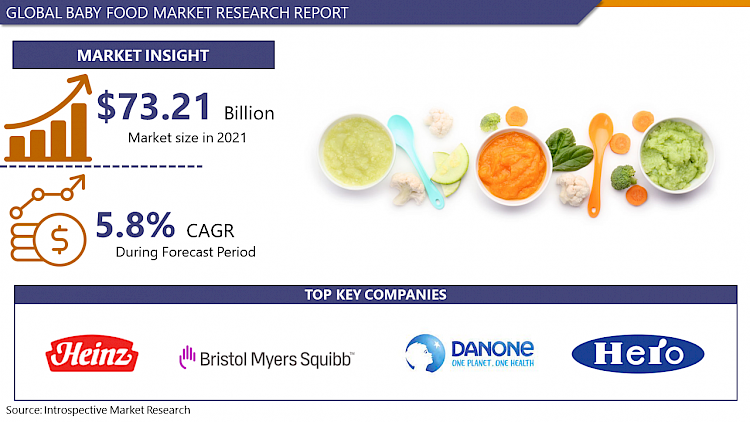Market Overview
Baby Food Market size is projected to reach USD 108.64 Billion units by 2028 from an estimated USD 73.21 Billion unit in 2021, growing at a CAGR of 5.8% globally.
Baby food is the food that is fed to newborn babies between the ages of four months to two years. In old days, babies are fed with soft home-cooked food; they don’t have teeth and to digest food easily parents fed them with soft, healthy, and easily digestible food such as purees or strained food, cereal-based foods, beverages and snack foods. Homemade baby food feeding practices are is still popular in developing countries. Changing culture growing urbanization and changing lifestyles have increased the demand for packaged baby foods around the globe. According to Statista as the world’s most populated country, China is the biggest market for baby food, with over 71.56 billion dollars in sales revenue, with India coming in second place the sales value of baby food in the Indian packaged food market was at 852.4 million U.S. dollars in 2021. The United States ranked in sixth place.
Major Key Players for Baby Food Market
- Nestle S.A. (Switzerland)
- H.J. Heinz (US)
- Bristol Myers Squibb (US)
- Danone S.A. (France)
- Hero Group (Switzerland)
- Abbott Nutrition (US)
- Mead Johnson and Company LLC (US).
- Cow and Gate
- Hipp
- Friso
- Organix
- Plum Baby
- Ella’s Kitchen
- Perrigo Nutritionals
- Bubs
- Hain Celestial Group
- Alter farmacia
Market Dynamics and Factors
The baby food market is increasing due to the growing awareness of nutrition-rich baby food products. In that stage, babies need all the nutrients for development and growth. The urbanization provided a significant increase in the count of working women providing high growth in the market. Increased purchasing power of people and less time available for people due to work. These factors are help to increase the demand for ready-to-eat and healthy baby food items. Additionally the rise in the organized retail market, shops are providing this food easily at door steps. These key factors are responsible for the boost in the baby food market. However, Concerns related to food safety, and feeding home-cooked food to babies are hampering the growth of the market.
Baby Food Market Report Highlight
- By product type, the baby food by milk formula segment is expected to have the maximum market share in baby food during the projected period. The milk formula is mostly the preferred food category for babies due to its protein, calcium, and vitamins.
- By distribution channels, the supermarket/hypermarket segment is predicted to expand the most in the baby food market during the forecast year. Supermarket/hypermarket is providing baby food in different types, flavors, and brands at one destination that boosts the growth of the market.
- By Age-Group, the infant segment is anticipated to dominate the baby food market during the forecast period. Infants are depending on the outer source for food and the increasing global birth rate provides growth to the market.
- By region, Asia-Pacific is expected to dominate the baby food market, during the projected period. The increasing birth rate, increasing purchasing power and changing lifestyle of people support the growth of the baby food market in Asia-Pacific.
Key Industry Development
- In January 2021, Timios, a Bangalore based packaged healthy snack brand for children, enters into the baby food market with the launch of its new category of ‘Made to Order’ Porridge range for infants and toddlers. This new product is designed for babies between ages of 6 to 18 months, and is available in 12 variants.
- In February 2022, Sprout Organics known for making delicious organic meals and snacks for babies and toddlers launches a co-branded product line with "CoComelon," across North America. Now bring that fun to mealtime with a sampling of veggie-packed purees and wholesome snacks made with real, organic ingredients.
Baby Food Market Segmentation
By Product Type
- Baby food by milk formula
- Baby food cereals
- Baby food frozen
- Baby food ready to eat
By Distribution Channels
- Supermarket/Hypermarket
- Specialty Store
- Local Retailers
- Others
By Age-Group
- Infants
- Toddlers
For this report, Introspective Market Research has segmented the Baby Food Market based on region
Regional Outlook (Revenue in USD Million; Volume in Units, 2022-2028)
- North America
- The U.S.
- Canada
- Mexico
- Europe
- Germany
- France
- UK
- Italy
- Turkey
- Rest of Europe
- Asia Pacific
- China
- India
- Japan
- South Korea
- Indonesia
- Vietnam
- Thailand
- Rest of Asia-Pacific
- Middle East & Africa
- Saudi Arabia
- South Africa
- Iran
- Rest of MEA
- Latin America
- Brazil
- Argentina
- Rest of LATAM







